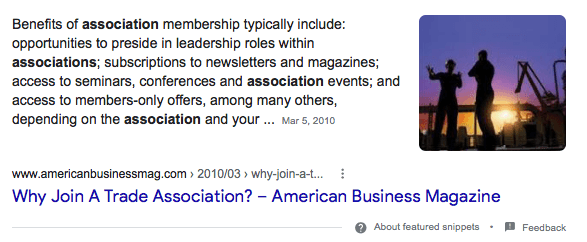In recent years, Google has been trying to find ways to get people the answers they are looking for without having to leave the Google search engine results page (SERP). One way they use to achieve this is the featured snippet. These can appear with traditional Google searches or voice searches which are growing in popularity. Featured snippets are boxes of text that answer a query and appear above the coveted top three results on the SERP. This has come to be known as “position zero”. These featured snippets pull the answer to the query from a content piece on a website and post the “snippet” along with a link to the full piece in a box at the top of the page. This allows people to get the answers they are looking for quickly without having to go to any website, but if they wish to know more, they can follow the link to the full piece.
While there is no exact science to getting your association’s content into featured snippets, there are things you can do to greatly improve your chances.
Understanding What a Featured Snippet Is
Before you can begin to think about trying to earn a featured snippet, you should know a few things about them. Featured snippets are usually answers to who, what, when, where, why, and how questions. Google ranks websites and content based on the reputation and factualness of the content and from there pulls answers to feature in the snippet. For example:
 If you search “Why join a trade association?”
If you search “Why join a trade association?”
You will see this featured snippet appeared at the top of the page. This particular snippet was pulled from www.americanbusinessmag.com and features a basic answer to the question “Why Join a Trade Association?”. It also gives the user the chance to follow the link to learn more, thus increasing chances of someone visiting your website.
Snippets can appear in different forms including paragraph snippets like the one above, numbered or bulleted lists, and tables. Which snippet type that your content is featured in will depend on the type of content you create.
How to “Own” the Featured Snippet
As previously stated, there is not an exact science to winning the featured snippet, but there are steps you can take with your association’s content to increase your chances.
- Find out what people want to know
For this first step, you really have to think like your audience; this could be existing members or potential members. Think of the questions you receive and try to focus strong content around answering those questions. Again, featured snippets are answers to who, what, when, where, why, and how questions. Keep this in mind when brainstorming potential audience questions. A good resource for finding what people are asking is www.answerthepublic.comwhere you can search specific terms and see what people are searching for regarding that term.
We searched “trade associations” and you can see a part of the wheel we got as a result. This image includes the who and how results. One popular question is “what do trade associations do?” so that may be a good topic for content for you to focus on.
- Research Snippets in Your Industry
A good way to find opportunities for snippets for your association is to go to Google and begin typing the questions that you came up with. This will allow you to see if there are existing snippets or if there is an open opportunity for you to own the snippet. Even if there are existing snippets, if you tailor you content right, you can still take control of that snippet. Also be sure to pay attention to the “People also ask” section that appears further down the SERP. Below is the “People also ask” box that appears when we entered the question “What is a trade association?”
This section also pulls from existing content online so there is also potential to have your content featured as an answer here as well.
- Strong Website, Strong Content, Strong SEO
One of the most important factors in having your association’s content chosen for the featured snippet is making sure your website is optimized, easy to navigate, and functioning well. This is one of the first things Google looks at when determining whether your page should appear on the first page of the SERP or in the featured snippet. If your website is slow and not user friendly by Google’s terms, even if your content is outstanding, you may be overlooked when it comes to the featured snippet. Not only that, but your website will get pushed further back on the SERP making it hard to find and less likely to be visited.
Also, devoting time to keyword research and using popular keywords in your content will help not only win the featured snippet, but also rank you higher on the Google SERP. Using backlinks, cross-linking, and releasing content consistently and regularly can also go far to increase your ranking and raising you up on the search engine results page (SERP).
You Can Do It
It takes work, but you can earn the featured snippets and even improve your position on Google’s search engine results page at the same time. There are many other factors that improve your chances for securing snippets and improving your SEO. If you would like further information or help with your association’s website or content marketing, contact us here.



